Armed Forces of the Philippines
| Armed Forces of the Philippines | |
|---|---|
| Sandatahang Lakas ng Pilipinas | |
 Seal of the Philippine Armed Forces | |
 Flag of the Armed Forces of the Philippines | |
| Motto | "Protecting the People, Securing the State" |
| Founded | December 21, 1935 |
| Service branches |
|
| Headquarters | Camp General Emilio Aguinaldo, Quezon City |
| Website | www |
| Leadership | |
| Commander-in-Chief of the Armed Forces of the Philippines | President Rodrigo R. Duterte |
| Secretary of National Defense | Sec. Delfin N. Lorenzana |
| Chairman of the Joint Chiefs | Lt. Gen. Jose Faustino Jr., PA |
| Vice Chairman of the Joint Chiefs | Lt. Gen. Erickson R. Gloria, PAF |
| Chief of the Joint Staff | VADM Erick A. Kagaoan, PN |
| Sergeant Major of the Armed Forces | FCMSgt. Aladin S. Dacayanan, PA |
| Manpower | |
| Military age | 18–56 years old |
| Conscription | None enforced, optional through Reserve Officers' Training Corps (ROTC) and Basic Citizen's Military Training (BCMT) |
| Available for military service | 46,947,750 (2021)[1], age 18–56 |
| Fit for military service | 38,497,155 (2021)[1], age 18–56 |
| Reaching military age annually | 1,924,858 (2021)[1] |
| Active personnel | 140,000 (2020)[1] (ranked 35th) |
| Reserve personnel | 360,000 (2020-Army, Navy, Air Force Ready Reserves) 770,000 (Total Reservist)[2] |
| Expenditures | |
| Budget | ₱206.443 billion US$ 4.26 billion (2021)[3] |
| Percent of GDP | 1.17% (2021) |
| Industry | |
| Domestic suppliers | show List |
| Foreign suppliers | show List |
| Related articles | |
| History | Military history of the Philippines List of wars involving the Philippines List of conflicts in the Philippines show List of engagements |
| Ranks | Military ranks of the Philippines Cadet rank in the Philippines |

The Armed Forces of the Philippines (AFP) (Filipino: Sandatahang Lakas ng Pilipinas) are the military forces of the Philippines. It consists of three main service branches; the Army, the Air Force, and the Navy (including the Marine Corps). The President of the Philippines is the Commander-in-Chief of the AFP and forms military policy with the Department of National Defense, an executive department acting as the principal organ by which military policy is carried out, while the Chief of Staff of the Armed Forces of the Philippines serves as the overall commander and the highest-ranking officer in the AFP. The Philippine Coast Guard also serves as an attached service of the AFP in wartime. Military service is entirely voluntary.[4]
Leadership[]
- Commander-in-chief – President Rodrigo R. Duterte
- Secretary of National Defense – Sec. Delfin N. Lorenzana
- Undersecretary of National Defense - Usec. Cardozo M. Luna
- National Security Adviser - Hermogenes C. Esperon Jr.
- Presidential Adviser for Military Affairs - Sec. Arthur I. Tabaquero
AFP Chain of Command[]
| Chief of Staff of the Armed Forces of the Philippines | Appointed | Branch | |
|---|---|---|---|
| Lieutenant General Jose Faustino Jr.[5] | 31 July 2021 (31 days) |
 Philippine Army (Infantry and Special Operations) | |
| Vice Chief of Staff of the Armed Forcs of the Philippines | Appointed | Branch | |
| Lieutenant General Erickson R. Gloria[6][7] | 21 November 2020 (283 days) |
 Philippine Air Force (Helicopters and Staff) | |
| Deputy Chief of Staff of the Armed Forces of the Philippines | Appointed | Branch | |
| Vice Admiral Erick A. Kagaoan[8][9] | 3 October 2020 (332 days) |
 Philippine Navy (Naval Squadron and Staff) | |
| Commanding General of the Philippine Army | Appointed | Branch | |
| Major General Andres C. Centino[10] | 18 May 2021 (105 days) |
 Philippine Army (Infantry and Special Operations) | |
| Flag Officer in-Command- Philippine Navy | Appointed | Branch | |
| Vice Admiral [11][12] | 8 June 2021 (84 days) |
 Philippine Navy (Naval Squadron, Intelligence, and Education and Training) | |
| Commanding General of the Philippine Air Force | Appointed | Branch | |
| Lieutenant General Allen T. Paredes[13][14][15] | 16 January 2020 (1 year, 227 days) |
 Philippine Air Force (Logistics and Staff) | |
| Commandant of the Philippine Marine Corps | Appointed | Branch | |
| Major General Ariel R. Caculitan[16] | 20 December 2020 (254 days) |
Philippine Marine Corps (Naval Infantry) | |
| Sergeant Major of the Armed Forces of the Philippines | Appointed | Branch | |
| First Chief Master Sergeant Aladin S. Dacayanan[17][18] | 29 October 2020 (336 days) |
 Philippine Army (Infantry) | |
History[]
Pre-colonial Philippines maintained local militia groups under the barangay system. Reporting to the datu, these groups, aside from maintaining order in their communities, also served as their defense forces. With the arrival of Islam, the system of defense forces in the Mindanao region's sultanates under Muslim control mirrored those other existing sultanates in the region. These local warriors who were in the service of the Sultan were also responsible to qualified male citizens appointed by him.
During the Spanish colonial period, the Spanish Army was responsible for the defense and general order of the archipelago in the land, while the Spanish Navy conducts maritime policing in the seas as well as providing naval logistics to the Army. The Guardia Civil took police duties and maintaining public order in villages and towns. In the early years of Spanish colonial era, most of the formations of the army were composed of conquistadors backed with native auxiliaries. By the 18th and 19th centuries, line infantry and cavalry formations were created composed of mixed Spanish and Filipino personnel, as well as volunteer battalions composed of all-Filipino volunteers during the later half of the 19th Century. Units from other colonies were also levied to augment the existing formations in the Philippines. Almost all of the formations of the Spanish Army in the archipelago participated in the local religious uprisings between 17th and 19th centuries, and in the Philippine Revolution in 1896 fighting against the revolutionary forces. At the peak of the revolution, some Filipinos and a few Spaniards in the Spanish Army, Guardia Civil, and Navy defected to the Philippine Revolutionary Army.
The Spanish cession of the Philippines in the 1898 Treaty of Paris put the independence of the newly declared Southeast Asian republic in grave danger. The revolutionaries were fighting desperately as the American forces already landed in other islands and had taken over towns and villages. The Americans established the Philippine Constabulary in 1901 manned by Filipino fighters and used against Gen. Aguinaldo who was later captured.
On April 9, 2002, Philippine President Gloria Macapagal Arroyo proclaimed that the Philippine–American War had ended on April 16, 1902, with the surrender of General Miguel Malvar.[19]
Since the beginning of American rule in the Philippines, the United States Army had taken the responsibility for the defense of the country in the land, and the United States Navy in the seas until the passage of the National Defense Act of 1935 which called for a separate defense force for the Philippines.
Creation and World War II[]
In accordance with the National Defense Act of 1935, the Armed Forces of the Philippines was officially established on December 21, 1935, when the act entered into force.[20] Retired U.S. General Douglas MacArthur was asked to supervise its foundation and training. MacArthur accepted the offer and became a Field Marshal of the Philippines, a rank no other person has since held.[21] Jean MacArthur, his wife, found the situation amusing and remarked that her husband had gone from holding the highest rank in the United States Army to holding the highest rank in a non-existent army. President Quezon officially conferred the title of Field Marshal on MacArthur in a ceremony at Malacañan Palace on August 24, 1936, when he appeared with a gold marshal's baton and a unique uniform.[22]
The Army of the Philippines included naval and air assets directly reporting to Army headquarters, and the Philippine Constabulary, later part of the ground forces proper as a division. In 1938 the Constabulary Division was separated from the army and reorganized into a national police force.[23][24]
MacArthur expanded the Army of the Philippines with the revival of the Navy in 1940 and the formation of the Philippine Army Air Corps (formerly the Philippine Constabulary Air Corps), but they were not ready for combat at the start of the Pacific War in December 1941 and unable to defeat the 1941–42 Japanese invasion of the Philippines.
In 1940–41, most soldiers of the Philippine military were incorporated in the U.S. Army Forces Far East (USAFFE), with MacArthur appointed as its commander. USAFFE made its last stand on Corregidor Island, after which Japanese forces were able to force all remaining Filipino and American troops to surrender. The establishment of the general headquarters of the Philippine Commonwealth Army are military station went to the province during the occupation. Those who survived the invasion but escaped from the Japanese formed the basis of recognized guerrilla units and ongoing local military force of the Philippine Commonwealth Army that continued the fighting against the enemy all over the islands. The Philippine Constabulary went on active service under the Armed Forces of the Philippines during liberation. After Japan was defeated in World War II, the Philippines gained its independence in 1946. (This was its second independence after the Philippine Declaration of Independence in 1898). In 1947 the modern AFP first emerged with the upgrade of the PAAC to the Philippine Air Force.
After independence[]
1950 saw the creation of the Philippine Marine Corps, a naval infantry force under the command of the Philippine Navy, after then-Defense Secretary Ramon Magsaysay ordered Commodore Ramon Alcaraz to go to study the organization of the U.S. Marines. Alcaraz recommended the creation of the new service, earning him the distinction of being the "Father" of the Philippine Marine Corps.[25]
During the Korean War from 1951 to 1953, the Philippines sent various AFP battalions, known as the Philippine Expeditionary Forces to Korea (PEFTOK) to fight as part of the US-led United Nations Command in liberating South Korea from the invading North Korean troops.
At the same time, the armed forces fought against Communist elements of the Hukbalahap (by then the Bagong Hukbong Bayan, the Philippine counterpart of the PLA) in Central Luzon, two Southern Tagalog provinces and several Visayan provinces, with great successes.
In 1966, an AFP battalion was also sent into South Vietnam during the Vietnam War to ameliorate the economic and social conditions of its people there. AFP units were also sent at the same time to the Spratly Islands.
1963 would see the first women join the ranks of the armed forces with the raising of the Women's Auxiliary Corps.
Martial law[]
President Ferdinand Marcos sought to have a strong personal influence over the Armed Forces as soon as he became president in 1965,[26][27](p"32") holding on to the portfolio of defense secretary in the first thirteen months of his presidency[28] to develop what scholars have noted to be "a patronage system within the defense establishment."[29] The portfolio afforded him direct interaction with the AFP's leadership, and to have a hand in the AFP's day-to-day operationalization.[30]
Upon the declaration of Martial Law in 1972, Marcos used the AFP as what the Davide Commission Report would later call his "martial law implementor,"[31] and "one of the vital supports of the regime."[31] Upon the announcement of Martial Law in 1972, one of their earliest tasks was that of quickly arresting and containing Marcos' political opponents,[32] and Marcos' hold on power was effectively broken once enough of the Military withdrew their support from him in February 1986.[33] Parlade notes that to get the military to ensure their cooperation, Marcos "had to expand the military organization and patronize the generals to buy their loyalty."[26][34]
Marcos oversaw a significant expansion of the AFP, which grew from a force of 57,100 in 1971 to a 97.89 percent increase of 113,000 personnel in 1976 - a significant increase of over a five-year period.[31] He also increased the military budget from P880 million in 1972 to P4 billion in 1976.[31] Marcos also instituted the AFP Self Reliance Defense Posture (SRDP) program, which was supposed to enable the AFP to construct its own weapons, tanks, ships and aircraft locally instead of buying from foreign sources.[35] This included[citation needed] "Project Santa Barbara" under the Philippine Navy, which saw the testing of the Bongbong II MLRS - named after Marcos' son - in 1972. However, the project was discontinued before the Marcos administration ended. [36][undue weight? ][better source needed]
The military was given many functions aside from its task of national defense, including assisting in the implementation of price controls imposed on key products like corn and rice, enforcing the rules of the national corn procurement program, assisting in the collection of rural and government bank loans, implementing the agrarian reform law, and various police functions such as collecting unlicensed firearms and enforcing curfews, and suppressing strikes, rallies, and other demonstrations.[31]
Marcos carried out the "largest reshuffle in the history of the armed forces" when he forcibly retired fourteen of the AFP's twenty-five flag officers, including the AFP Chief of Staff, the AFP Vice Chief of Staff, the commanding general of the Philippine Army, the Chief of the Philippine Constabulary, the commanders of all four Constabulary Zones, and one third of all Provincial Commanders of the PC.[37] Other key officers critical of Marcos, such as Commodore Ramon Alcaraz, were compelled to leave the service.[25] In their place, Marcos appointed officers from his home region, the Ilocos, the most significant of whom had familial connections to Marcos – ensuring their familial and regionalistic loyalties to him.[30][29]
Among the most prominent such appointments were that of General Fabian Ver as commander of the Presidential Security Command in 1965, and AFP chief of staff in 1991;[38][39] Juan Ponce Enrile as Secretary of Defense from 1970 to 1986;[38] and General Fidel Ramos as chief for the Philippine Constabulary, and later as Armed Forces Vice Chief from 1981 to 1986.[38]
Generals loyal to Marcos were allowed to stay in their positions past their supposed retirement age, or were rewarded with civilian government posts.[40] This led to a loss of morale among the middle-ranks of the AFP, because it meant a significant slowdown in promotions and caused many officers to retire with ranks much lower than they would otherwise have earned.[30][37]
Several cabals of dissatisfied officers eventually formed among the middle-ranks of the AFP, most notably the Reform the Armed Forces Movement in the early 1980s.[37]
The Marcos administration is thus considered to have marked a decline for AFP in terms of its traditional values of civilian supremacy and professionalism,[41][42] leading to a need for security sector reform during later administrations,[42] as per the recommendations of the Davide Commission in 1990 and the Feliciano Commission in 2003.[43][44]
Civilian[45][46] and military[26] historians alike agree that "human rights abuses by the troops became rampant"[26][34] during the Marcos administration,[26] as documented by international monitoring entities such as Amnesty International.[47] Units often specifically cited in these reported incidents include the Metrocom Intelligence and Security Group (MISG),[48] and the 5th Constabulary Security Unit (5CSU)[49] of the Philippine Constabulary,[50] as well as the Intelligence Service of the Armed Forces of the Philippines (ISAFP).[51] The Presidential Security Unit and the National Intelligence and Security Agency (NISA) were also accused of aiding these activities.[52] Aside from human rights abuses, these units were also accused of hounding media entities,[53][54] corporate management,[55] and opposition groups[56] with threats, intimidation, and violence.
The Marcos administration also marked the beginnings of at least two long-running conflicts which continued to plague later administrations: the Moro conflict and the New People's Army conflict.[57]
The Moro conflict, began in earnest in 1968 when short-lived organizations like the Muslim Independence Movement and the Bangsamoro Liberation Organization formed in reaction to news about the Jabidah Massacre,[58][59][60] with many of their forces eventually coalescing as the Moro National Liberation Front was formed in 1972.[57][58]
Meanwhile, the Communist Party of the Philippines formed in 1968 and began its New People's Army in 1969,[57] growing nationwide to a 200,000 strong force.[citation needed]
EDSA Revolution[]
Due to what was popularly believed to be electoral fraud during the 1986 Philippine presidential election,[61] February 1986 saw period of uncertainty.[62][63] A boycott movement and plans for massive civilian protests were in place.[64] During the chaos, a faction of AFP headed by then Defense Minister Juan Ponce Enrile and AFP vice-chief of staff Lt. General Fidel V. Ramos decided to stage a military coup against Marcos.[65] The plot was uncovered,[66] however, and the forces involved became trapped in the neighboring Camp Aguinaldo and Camp Crame in Quezon City. Manila's Catholic Archbishop, Jaime Sin, went on Radio Veritas and called for people to go to the section of Epifanio de los Santos Avenue in between the two camps and help protect the rebel forces.[65] Since civilian groups were already planning massive protests in relation to the election results, a large crowd was able to gather and prevent Marcos' forces from attacking camps Aguinaldo and Crame.[67][68]
This ushered in the People Power Revolution, in which unarmed civilians were largely responsible for removing Marcos from power.[69][70] Corazon Aquino was then installed as the new president of the Philippines.[citation needed]
Later 20th Century[]
During Corazon Aquino's administration, most of the military units remained loyal to her as she dealt with various coup attempts against her, either by military factions that remained loyal to the former dictator,[31](p135) or by the Reform the Armed Forces Movement.[31] The 1989 coup attempt, the bloodiest of all coup attempts against her, was crushed with US help.[citation needed]
Following the 1989 coup attempt, President Aquino established a Fact-Finding Commission headed by COMELEC Chairman Hilario Davide Jr. to investigate and provide a full report on the series of coup attempts.[71][72] When it came out, The Davide Commission Report recommended several short-term and long-term counter-measures, including the establishment of a civilian national police force, a crackdown on corruption in the military, a performance review of appointive government officials, reforms in the process of military promotions, a review of election laws in time for the 1992 presidential elections, and a definitive statement on the part of Aquino on whether she intended to run for re-election in 1992.[31](pp509-530)[73] The publication of the recommendations of the report is considered one of the key starting points of security sector reform in the Philippines.[42][43]
The AFP, during her term also launched a massive campaign against the CPP-NPA after a brief hiatus and also against the MNLF in the south.[citation needed]
In 1991, the major services of the AFP were reduced from four to three, when the Philippine Constabulary or PC, an AFP major service tasked to enforce the law and to curb criminality, was formally merged with the country's Integrated National Police, a national police force on the cities and municipalities in the country attached to the PC to become the Philippine National Police, thus removing it from AFP control and it was civilianized by a law passed by Congress, therefore becoming under the Department of the Interior and Local Government as a result.[74]
Contemporary history[]
In 2000, then President Joseph Estrada ordered the AFP to launch an "All-Out war" against the Moro Islamic Liberation Front, a breakaway group of the MNLF that wants to proclaim Mindanao an independent state.
In 2001, Estrada was removed from power in the two-day Edsa Dos People Power revolt, in which the AFP played a key role. The revolution installed then Vice-President Gloria Macapagal Arroyo as president.
Since 2001, the Armed Forces of the Philippines has been active in supporting the War on terror and has been attacking terrorist groups in Mindanao ever since. In 2012, the AFP Chief of Staff said that there had been no increase in the number of soldiers over a long period, and that the military aimed to hire 30,000 troops in three years.[75]
In 2013, the AFP managed to stall the attacks of the Moro National Liberation Front in the Zamboanga City crisis as they launch an attack to proclaim the independence of the Bangsamoro Republik. In 2016, the AFP clashed with the Maute group on Butig on February and on November of 2016. In 2017, The AFP also clashed with ISIS Militants in Marawi, calling President Duterte to declare Martial Law under Proclamation No. 216.
After the signing of the Comprehensive Agreement on the Bangsamoro in 2014, the AFP has played a key part in the normalization process with the MILF, which includes "the decommissioning of MILF combatants and their weapons and the transformation of several camps into productive and resilient communities,"[76] developing a close working relationship with the Philippine National Police and the MILF-Bangsamoro Islamic Armed Forces (BIAF) in the pursuit of peace in the Bangsamoro.[77]
Organization and branches[]
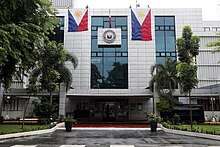
The 1987 Philippine Constitution placed the AFP under the control of a civilian, the President of the Philippines, who acts as its Commander-in-Chief. All of its branches are part of the Department of National Defense, which is headed by the Secretary of National Defense.
The AFP has three major services:[78]
- Philippine Army (PA) – Hukbong Katihan ng Pilipinas
- Philippine Navy (PN) – Hukbong Dagat ng Pilipinas
- Philippine Marine Corps (PMC) – Hukbong Kawal Pandagat ng Pilipinas
- Philippine Air Force (PAF) – Hukbong Himpapawid ng Pilipinas
These three major services are unified under the Chief of Staff of the Armed Forces of the Philippines who normally holds the rank of General/Admiral. He is assisted by:
- The Vice Chief of Staff of the AFP (VCSAFP)
- The Deputy Chief of Staff of the AFP (DCSAFP)
Both normally holding the rank of Lieutenant General/Vice Admiral.
Each of the three major branches are headed by an officer with the following titles:
- Commanding General of the Philippine Army (Lieutenant General)
- Flag Officer in-Command (Vice Admiral)
- Commanding General of the Philippine Air Force (Lieutenant General)
- The Inspector General, AFP (Lieutenant General/Vice Admiral)
- Commander, Unified Command (Lieutenant General/Vice Admiral)
Meanwhile, the Chairman of the Joint Chiefs is also assisted by the 10 following office holders carry the rank of Major General/Rear Admiral at the General Headquarters in Camp Aguinaldo:
- The Deputy Chief of Staff for Personnel, J1
- The Deputy Chief of Staff for Intelligence, J2
- The Deputy Chief of Staff for Operations, Organization & Training,J3
- The Deputy Chief of Staff for Logistics, J4
- The Deputy Chief of Staff for Plans, J5
- The Deputy Chief of Staff for Communications, Electronics and Information Systems Service, J6
- The Deputy Chief of Staff for Civil-Military Operations, J7
- The Deputy Chief of Staff for Education and Training, J8
- The Deputy Chief of Staff for Retirees and Reservists Affairs, J9
- The Deputy Chief of Staff for Financial Management, J10
He is also assisted by the following office commanding division-sized troops holders carry the rank of Major General/Rear Admiral:
- Army Division Commanders
- Naval Command Commanders
- Air Command Commanders
- The Commandant of the Philippine Marine Corps
On June 19, 2020, under the DND Order no. 174, the AFP had major changes in renaming its positions in high-ranking officials, such as the following:[79]
- Chief of Staff of the AFP - Chairman of the Joint Chiefs
- Vice-Chief of Staff of the AFP - Vice Chairman of the Joint Chiefs
- The Deputy Chief of Staff of the AFP - Chief of the Joint Staff
- Commander, Unified Command - Joint Forces Commander, Unified Command
- Deputy Chief of Staff for (functional area) (J-staff) - Deputy Chief of Joint Staff for (functional area)
- Commanding General of the Philippine Army - Chief of the Army
- Flag Officer in-Command - Chief of the Navy
- Commanding General of the Philippine Air Force - Chief of the Air Force
However, the AFP has deferred these title changes a few months later as President Rodrigo Duterte revoked the usage of the position titles, and decided to maintain the traditional position titles. [80]
Former branches[]
The Philippine Constabulary (PC) was a gendarmerie type para-military police force of the Philippines established in 1901 by the United States-appointed administrative authority, replacing the Guardia Civil of the Spanish colonial regime. On December 13, 1990, Republic Act No. 6975 was approved, organizing the Philippine National Police (PNP) consisting of the members of the Integrated National Police (INP) and the officers and enlisted personnel of the PC. Upon the effectivity of that Act, the PC ceased to be a major service of the Armed Forces of the Philippines and the INP ceased to be the national police and civil defense force.[81] On January 29, 1991, the PC and the INP were formally retired and the PNP was activated in their place.[82]
Unified commands[]
Units from these three services may be assigned to one of six "Unified Commands" led by each Commander of the Unified Command; consisting of different branches from the three branches of the AFP, which are multi-service, regional entities. The Unified Commands are responsible in monitoring, securing and defending their specific geographical area of operations within the Philippines. There are currently 6 Unified Commands in the AFP. Each JFC holds the rank of Lieutenant General/Vice Admiral, and reports to the office of the Chief of Staff of the Armed Forces of the Philippines.[83]
- Northern Luzon Command (NOLCOM) (Ilocos Region, Cordillera Administrative Region, Cagayan Valley, and Central Luzon, including the Scarborough Shoal and the Benham Rise)
- Southern Luzon Command (SOLCOM) (Calabarzon; Mimaropa excluding Palawan, and Bicol Region)
- Visayas Command (VISCOM) (Western Visayas, Central Visayas, Eastern Visayas)
- Western Command (WESCOM) (Palawan and the West Philippine Sea)
- Eastern Mindanao Command (EASTMINCOM) (Davao Region, Soccsksargen, and the Caraga regions)
- Western Mindanao Command (WESTMINCOM) (Zamboanga Peninsula, Northern Mindanao, and the BARMM Region)
Former Unified & Wide Support Commands[]
- National Capital Region Command (NCRCOM)
- National Development Support Command (NADESCOM)
- Southern Command (SOUTHCOM)
- National Capital Region Defense Command (NCRDC)
- Central Luzon Command (CELCOM)
- Internal Defense Command (IDC)
AFP-wide service support and separate units[]
Several service-wide support services and separate units report directly to the AFP General Headquarters (AFP GHQ), these include:
- Presidential Security Group (PSG)
- Philippine Military Academy (PMA)
- Armed Forces of the Philippines Officer Candidate School
- AFP Education, Training, and Doctrine Command (AFPETDC) under which is the Armed Forces of the Philippines Command and General Staff College (AFPCGSC)
- Armed Forces of the Philippines Reserve Command (AFPRESCOM)
- Intelligence Service, Armed Forces of the Philippines (ISAFP)
- AFP Health Service Command under which is the Armed Forces of the Philippines Medical Center (AFPMC) and Armed Forces of the Philippines Dental Service Center (AFPDSC)
- (AFPCES)
- Armed Forces of the Philippines Special Operations Command (AFPSOCOM)
- (AFP-PKOC)
- AFP Joint Task Force-National Capital Region (AFP JTF-NCR) – Replaced the deactivated NCR Commands
- AFP Doctrine Development Center (AFPDDC)
- Citizen Armed Force Geographical Unit (CAFGU)
Reforms and modernization[]
The AFP is one of the "core security actors"[43] that are the focus of security sector governance and reform in the Philippines, which involves civilianizing, professionalizing, modernizing, and capacitating the Philippine government’s security institutions[43][84][85] to align them good governance and to principles such as human rights, freedom of information, and the rule of civilian law.[86][87] This has been a continuing process since the establishment of the Fifth Philippine Republic after the 1986 People Power Revolution,[84] before the concept had even been fully defined internationally in the 1990s. [88]
Civilianization[]
The need to assert civilian control of the military was a reform agenda which began being addressed almost as soon as Ferdinand Marcos was deposed by the 1986 People Power Revolution; within a year of Marcos' ouster, the 1987 Constitution of the Philippines enshrined the principle of civilian supremacy over the military.[89] After the various coup attempts of the 1980s, the recommendations of the Davide Commission included the dissolution of the Philippine Constabulary as a service under the AFP, resulting in the eventual creation of the civilian Philippine National Police.[90] In 1998, Executive Orders 475 and 477 asserting the civilian nature of the Philippine Coast Guard and transferring it from the Philippine Navy to the Department of Transportation and Communications (DOTC) were signed by President Fidel Ramos.[91]
In a December 2013 paper for the National Defense College of the Philippines’ National Security Review, former Department of National Defense Undersecretary Rodel Cruz identified some aspects of civilianization which need attention under security sector reform as:[43]
- Increasing civilian capacity for defense management;
- Establishing an active constituency supportive of Security Sector Reform;
- Prudent budget preparation and execution;
- Supporting a local defense industry;
- Intelligent and coherent policy development and execution; and
- the passage of an updated National Defense Act.
Involvement of Civil Society[]
For the most part, oversight of the Philippine state's security actors has fallen on government agencies through the constitutional system of checks and balances - most prominently, congress and the Commission on Human Rights.[89] But civil society organizations have also become involved in civilianizing, professionalizing, modernizing, and capacitating the Philippine state's security institutions, depending on how much emphasis each President, as Commander in Chief, places on civil society engagement.[92]
Given a greater emphasis on Philippine Defense Reform (PDR) beginning in 2010, a shift towards engagement with Civil Society Organizations was put in place under the Internal Peace and Security Plan (IPSP) of 2010, and similar principles were enshrined in the 2016 AFP-Development Support and Security Plan (DSSP) of the next administration.[93] However, civil society is no longer identified as a major strategic priority under the 15 year AFP Transformation Roadmap initiated during the Duterte administration, as it had been under the 2003-2016 PDR Program.[94]
Professionalization[]
The AFP went through a number of changes during the 21 years under Ferdinand Marcos, notably in terms of the promotion of officers based on loyalty and connections to the president, and in terms of being given the task of implementing Martial Law, which led to officers being involved in human rights violations and in corruption.[43] The years fro, 1965 to 1986 are thus considered to have marked a decline for AFP in terms of its traditional values of civilian supremacy and professionalism,[41][42] leading to a need to actively professionalize the AFP.[42][43] The 1990 Davide Commission and 2003 Feliciano Commission made recommendations towards the professionalization of the AFP as early as 1990 and 2003, respectively.[41][43]
Under the Philippine Defense Reform (PDR) Program from 2003 to 2016, steps the AFP sought to take towards professionalization included the development of "Integrity Developement Programs", programmatic efforts to improve the quality of service performance, continuing development programs for commanders and staff, and reforms in the recruitment of enlisted personnel.[95] Alongside capability development, "professionalization of all ranks" is one of two strategic priorities identified by the 15 year AFP Transformation Roadmap which replaced the PDR Program during the Duterte administration.[96]
Modernization[]
Republic Act No. 7898, approved on February 23, 1995, declared it the policy of the State to modernize the AFP to a level where it can effectively and fully perform its constitutional mandate to uphold the sovereignty and preserve the patrimony of the Republic of the Philippines, and mandated specific actions to be taken to achieve this end[97] over a 15-year period ending in 2010.[98] Republic Act No. 10349, approved on December 11, 2012, amended RA7898 to establish a revised AFP modernization program[99] lasting another 15 years ending in 2027.[98] The act included new provisions for the acquisition of equipment for all the branches of AFP.[citation needed]
Philippine Defense Reform Program (2003-2016)[]
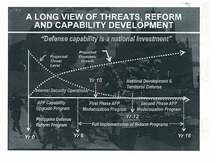
In October 1999, the Joint Defense Assessment (JDA) began as a policy level discussion between the Philippine Secretary of National Defense and the US Secretary of Defense. An initial JDA report in 2001 provided an objective evaluation of Philippine defense capability. During a May 2003 state visit to Washington DC, President Arroyo requested U.S. assistance in conducting a strategic assessment of the Philippine defense system. This led to a follow-up JDA and formulation of recommendations addressing deficiencies found in the Philippine defense structure.[100]
The results of the 2003 JDA were devastating. The JDA findings revealed that the AFP was only partially capable of performing its most critical missions. Moreover, the results pointed overwhelmingly toward institutional and strategic deficiencies as being the root cause of most of the shortcomings. A common thread in all: the lack of strategy-based planning that would focus DND/AFP on addressing priority threats and link capability requirements with the acquisition process.
Specifically, the 2003 JDA revealed critical deficiencies in the following specific areas:[101]
- Systemic approach to policy planning
- Personnel management and leadership
- Defense expenditures and budgeting
- Acquisition
- Supply and maintenance
- Quality assurance for existing industrial base
- Infrastructure support
During a reciprocal visit to the Philippines in October 2003 by U.S. President Bush, he and President Arroyo issued a joint statement expressing their commitment to embark upon a multi-year plan to implement the JDA recommendations. The Philippine Defense Reform (PDR) Program is the result of that agreement.
The JDA specifically identified 65 key areas and 207 ancillary areas of concern. These were reduced to ten broad-based and inter-related recommendations that later became the basis for what became known as the PDR Priority Programs. The ten are:[102] 1. Multi-Year Defense Planning System (MYDPS) 2. Improve Intelligence, Operations, and Training Capacities 3. Improve Logistics Capacity 4. Professional Development Program 5. Improve Personnel Management System 6. Multi-year Capabilities Upgrade Program (CUP) 7. Optimization of Defense Budget and Improvement of Management Controls 8. Centrally Managed Defense Acquisition System Manned by a Professional Workforce 9. Development of Strategic Communication Capability 10. Information Management Development Program
From the perspective of the Philippine Department of National Defense (DND), the framework for reforms is based on an environment of increasing economic prowess and a gradually decreasing threat level over time, and seeks to make the following improvements:[103] 1. Address AFP capability gaps to enable the AFP to effectively fulfill its mission. 2. Implement capability for seamless interoperability by developing proficiency in the conduct of joint operations, eliminating crisis handling by individual major services as done previously. 3. improve effectiveness of internal security operations. 4. Enhance capability to counter terrorism and other transnational threats. 5. Provide sustainment and/or long-term viability of acquired capabilities. 6. Improve cost-effectiveness of operations. 7. Improve accountability and transparency in the DND. 8. Increase professionalism in the AFP through reforms in areas such as promotions, assignments, and training. 9. Increase involvement of AFP in the peace process.

According to the goals stated in the Philippines Defense Reform Handbook: "The PDR serves as the overall framework to re-engineer our systems and re-tool our personnel."[104] The Philippine Defense Reform follows a three-step implementation plan:[105] 1. Creating the environment for reform (2004–2005); 2. Enabling the defense establishment (2005–2007); 3. Implementing and institutionalizing reform (2007–2010).
On September 23, 2003, President Arroyo issued Executive Order 240, streamlining procedures for defense contracts for the expeditious implementation of defense projects and the speedy response to security threats while promoting transparency, impartiality, and accountability in government transactions. Executive Order 240, creating the Office of the Undersecretary of Internal Control in the DND, mandated in part to institutionalize reforms in the procurement and fund disbursement systems in the AFP and the DND.[106] On November 30, 2005, the Secretary of National Defense issued Department Order No. 82 (DO 82), creating the PDR Board and formalizing the reform organizational set-up between the DND and the AFP and defining workflow and decision-making processes.[107]
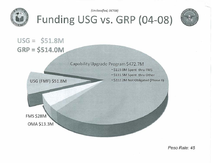
The PDR is jointly funded by the U.S. and R.P. governments. From 2004 to 2008, funding amounted to $51.8 million from the U.S. and $514.0 million from the RP.[108] Initial planning assumptioned that the 18-year span of reform would encompass a period of steady rise in economic growth coupled with equally steady decline in the military threat from terrorists and separatists. Neither of these projections have proven accurate. As of 2010, at the six-year mark of PDR, the Philippine economy was internally strong, but suffering during a period of recession that crippled Philippine purchasing power. Worse, the threat situation in the Philippines had not improved significantly, or as in the case of the Sulu Archipelago, was deteriorating.[109]
During the Arroyo presidency, deliberate 'Rolodexing' of senior leadership within the DND and AFP constantly put U.S. PDR advocates in a position of re-winning previously won points and positions, and gave U.S. observers a 'two steps forward, one step back' impression of the program. As of 2010, U.S. observers were uncertain whether Arroyo's successor, Benigno Aquino III, chosen in Philippine Presidential elections on May 10, 2010, will continue the tradition of rapid turnover of senior leadership.[110]
U.S. observers have reported that overall progress of the PDR is unmistakable and has clearly struck a wider swath of the Philippine defense establishment than originally hoped. However, they see some troubling signs that the depth of the PDR's impact may not be as significant as originally desired. For example, the Philippine legislature continues to significantly underfund the DND and AFP, currently at.9 percent of GDP, compared to an average of 2 percent worldwide, and a 4 percent outlay by the U.S. Even with full implementation of all the PDR's programs and recommendations, the defense establishment would not be able to sustain itself at current funding levels. While this can be made up by future outlays, as of 2010 observers see no outward sign the legislature is planning to do so.[110] One U.S. observer likened PDR process to the progress of a Jeepney on a busy Manila avenue—explaining, "a Jeepney moves at its own pace, stops unexpectedly, frequently changes passengers, moves inexplicably and abruptly right and left in traffic, but eventually arrives safely."[111] President Aquino has promised to implement the PDR program.[112] As of 9 March 2011, a major Philippine news organization tracking performance on his promises evaluated that one as "To Be Determined."[113]
The Mutual Defense Treaty between the Philippines and the United States has not been updated since its signing in 1951. As of 2013, discussions were underway for a formal U.S.-Philippine Framework Agreement detail how U.S. forces would be able to "operate on Philippine military bases and in Philippine territorial waters to help build Philippine military capacity in maritime security and maritime domain awareness."[114] In particular, this Framework Agreement would which would increase rotational presence of American forces in the Philippines.[115]
Longstanding treaties, such as the aforementioned 1951 Mutual Defense Treaty and the United Nations Convention on the Law of the Sea (UNCLOS) of 1982,[116] are of great importance to the Philippines in supporting maritime security in particular; respectively, their legally binding nature provides long-term effectiveness for mutual defense cooperation and for the development of the Philippine maritime and archipelagic domain.
Philippine defense operations are supported in part through U.S. Section 1206 ($102.3 million) and 1207 ($16.02 million) funds. These funds are aimed at carrying out security, counterterrorism training and rule of law programs.[117] Overall, the United States is increasing U.S. funding for military education and training programs in Southeast Asia. The most recent U.S. Department of Defense budget for the region includes $90 million for programs, which is a 50 percent increased from four years ago.[118]
Defense Secretary Voltaire T. Gazmin formally ended the PDR Program on June 23, 2016 because the upcoming administration of Rodrigo Duterte, which would begin its term later that month, had indicated that it wanted to set its own direction for the running of Philippine defense matters.[119]
National policies[]
Recent national policies have shifted the strategic direction of the AFP towards external, territorial defense as opposed to previous, internal foci. Some of the challenges with this change in strategic direction include the uneven distribution of maritime security resources among territorial, transnational, environmental, and humanitarian assistance and disaster response (HADR) conflicts.[120] For example, Philippine Executive Order 57, signed in 2011 by President Benigno Aquino III, established a central inter-agency mechanism for enhancing governance in the country's maritime domain.[121] Between 1995 and 2019, the AFP Reserve Manpower in the Philippines totaled 741,937 and 4,384,936 ROTC Cadets.[122] Out of the 700,00+ reservists; 93,062 are (ready reserve) and 610,586 are (standby reserve).[123] There are a total of 20,451 with the affiliated reserve units.[123]
Conflicts over responsibility for maritime surveillance between armed forces continue to underscore the numerous challenges that the TBA faces. For example, following the expulsion of Ferdinand Marcos from the Philippines in 1986, the Philippine Coast Guard separated from the Philippine Navy, resulting in an uneven distribution of resources and jurisdictional confusion.[124]
Recognition and achievements[]
Throughout the years, the AFP received numerous recognitions and commendation within the local sectors, the national government and in the international community. One example is the Philippine Army shooting team, wherein the unit was the overall champion in a two-week competition held in Australia, in 2013.[125] The Philippine Army shooting team won 14 gold medals, 50 silver medals and two bronze medals in Australian Army Skills at the Arms Meeting (AASAM) 2014.[126]
The 7th Philippine Contingent peacekeepers to the Golan Heights were awarded the prestigious United Nations Service Medal for the performance of their mission.[127]
Ranks[]
The officer ranks are as follows:[128][129]
| Rank group | General/flag officers | Field/senior officers | Junior officers | Officer cadet | ||||||||||||||||||||||||||||||||
|---|---|---|---|---|---|---|---|---|---|---|---|---|---|---|---|---|---|---|---|---|---|---|---|---|---|---|---|---|---|---|---|---|---|---|---|---|

|

|

|

|

|

|

|

|

|

|
|||||||||||||||||||||||||||
| General | Lieutenant general | Major general | Brigadier general | Colonel | Lieutenant Colonel | Major | Captain | First lieutenant | Second lieutenant
| |||||||||||||||||||||||||||
 
|
 
|
 
|
 
|

|

|

|

|

|

| |||||||||||||||||||||||||||
| Admiral | Vice admiral | Rear admiral | Commodore | Captain | Commander | Lieutenant commander | Lieutenant | Lieutenant (junior grade) | Ensign
| |||||||||||||||||||||||||||

|

|

|

|

|

|

|

|

|

|
|||||||||||||||||||||||||||
| General | Lieutenant general | Major general | Brigadier general | Colonel | Lieutenant colonel | Major | Captain | First lieutenant | Second lieutenant
| |||||||||||||||||||||||||||
| Rank group | General/flag officers | Field/senior officers | Junior officers | Officer cadet | ||||||||||||||||||||||||||||||||
These ranks, heavily inspired by those of the United States Armed Forces, are officially used in the Philippine Army, Air Force and Marine Corps. The ranks are more frequently referred and addressed in English rather than in Spanish or Tagalog/Filipino, since English is the working language within the Armed Forces.
The ranks in the Philippine Navy are similar to the US Navy ranks, the only difference is the rank of Commodore in the Philippine Navy is equivalent to the Lower Half Rear Admiral of the US Navy.
The alternative style of address for the ranks of lieutenant junior grade, lieutenant senior grade, second lieutenant, and first lieutenant are simply lieutenant in English, or tenyente or teniente in Tagalog and Spanish, respectively.
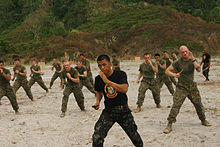
The ranks of enlisted personnel in Filipino are the same as their U.S. counterparts, with some differences. Except in the Marine Corps, never used are the ranks of specialist, sergeant first class, and first sergeant. Lance corporal, gunnery sergeant, and master gunnery sergeant are also never used by the Philippine Marine Corps, whose ranks are the same as the Army's. Additionally, sergeant majors in the AFP are only appointments for senior ranked non-commissioned officers (NCOs) rather than ranks, examples of such appointments being the Command Sergeant Major, AFP (held by a first chief master sergeant or a first master chief petty officer) and the Command Master Chief Petty Officer, Philippine Navy (held by an either MCPO or CMS or a SCPO or SMS).
In the Philippine Navy, they also use enlisted ranks which come from the U.S. Navy with their specialization, e.g. "Master Chief and Boatswain's mate Juan Dela Cruz, PN" (Philippine Navy).
In effect, the AFP uses the pre-1955 US military enlisted ranks, with several changes, especially in the Navy and in the senior NCO ranks.
There are no warrant officers in between officer ranks and enlisted ranks.
The uniqueness of Philippine military ranks can be seen in the current highest ranks of first chief master sergeant (for the Army, Marine Corps and Air Force) and first master chief petty officer (for the Navy), both created in 2004, and since then have become the highest enlisted rank of precedence. Prior, first chief sergeant and master chief petty officer were the highest enlisted ranks and rates, the former being the highest rank of precedence for Army, Air Force and Marine NCOs. Today only the rank of first master chief petty officer is unused, but the rank of first chief master sergeant is now being applied.
Five-star rank[]
President Ferdinand Marcos, who acted also as national defense secretary (from 1965 to 1967 and 1971 to 1972), issued an order conferring the five-star officer rank to the President of the Philippines, making himself as its first rank holder.[citation needed] Since then, the rank of five-star general/admiral became an honorary rank of the commander-in-chief of the armed forces whenever a new president assumes office for a six-year term, thus making the President the most senior military official.[131]
The only career military officer who reached the rank of five-star general/admiral de jure is President Fidel V. Ramos (USMA 1950) (president from 1992 to 1998) who rose from second lieutenant up to commander-in-chief of the armed forces.[132]
General of the Army Douglas MacArthur was also made Field Marshal of the Philippine Army with five-star rank in 1938, the only person to hold that rank. Emilio Aguinaldo, the first President of the Philippines, holds an equivalent of five-star general under the title Generalissimo and Minister/Field Marshal as the first commander-in-chief of the AFP.
The position is honorary and may be granted to any military officer, especially generals or admirals who had significant contributions and showed heroism, only in times of war and national defense concerns and emergencies. The highest peacetime rank is that of four-star general which is being held only by the AFP Chief of Staff. However, no law specifically establishes the rank of five-star general in the Armed Forces of the Philippines unlike in the United States and other countries.
Rank insignia[]
The AFP, like the military forces of Singapore and Indonesia, uses unitary rank insignia for enlisted personnel, in the form of raised chevrons increasing by seniority, save for the Philippine Air Force which uses inverted chevrons from Airman 2nd Class onward only since recently.[133] In the Philippine Navy these are supplemented by rating insignia by specialty, similar to the United States Navy. Like the British and Spanish armed services, however, senior ranked NCOs (especially in the Philippine Navy) also wear shoulder rank insignia only on the mess, semi-dress and dress uniforms, and in some cases even collar insignia. Like the US military all NCOs wear sleeve stripes to denote years of service in the enlisted ranks. Sleeve insignia for enlisted personnel in the Army and the Navy are similar but are different from those used in the US while those in the Marine Corps mirror its US counterpart but with special symbols from Master Sergeants onward (adopted in the early 2000s).
Officer ranks in the AFP are inspired by revolutionary insignia used by the Philippine Army after the 1898 declaration of independence. These are unitary rank insignia used in the every day, combat, duty and technical uniforms both on shoulders and collars (the latter in the khaki uniforms of the Navy), but in the semi-dress, dress and mess uniforms are different: The Army, Air Force and Marine Corps use unitary rank insignia on the shoulder board but the Navy uses the very same rank insignia format as in the US Navy except for the star (for Ensigns to Captains) in almost all officer uniforms and all general officer and flag officer shoulder boards in the full dress uniform are in gold colored backgrounds with the rank insignia and the AFP seal (the star arrangement is the same in the Army, Air Force and Marines but is different in the Navy). The Navy uses sleeve insignia only on its dress blue uniforms. Lieutenants and Captains wear 1 to 3 triangles (and Navy Ensigns and Lieutenants (junior and senior grades) in their working, duty and combat uniforms) while Majors, Lieutenant Colonels and Colonels wear 1, 2, and 3 suns (both triangles and suns have the ancient baybayin letter ka (K) in the center) as well as Navy superior officers (Lieutenant Commanders, Commanders and Captains) in their working, duty and combat uniforms respectively.
Gallery[]
- Armed Forces of the Philippines
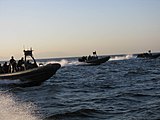
Philippine Navy rigid hull inflatable boats perform a maritime interdiction operation exercise in Manila Bay.
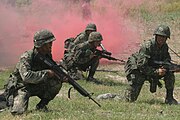
Philippine Marine Corps push forward after splashing ashore in an amphibious assault vehicle during an exercise.
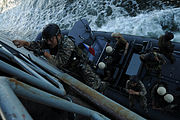
A NAVSOG unit climbs a caving ladder aboard the BRP Dagupan City during a maritime interdiction exercise.

Philippine Army Staff Sgt. Manolo Martin demonstrates the proper way to hold a king cobra during survival course training.
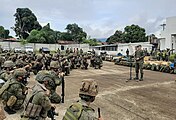
Soldiers of the Philippine Army 11th "Alakdan" Infantry Division

Airmen of the 710th Special Operations Wing prepare to jump from a KC-130 during Parachute Operations training.

A Philippine Army M113A2 FSV equipped with a UT30 25mm RCWS, being offloaded from BRP Tarlac (LD-601) in Iligan City during the Battle of Marawi.
The Northrop F-5 was the primary multi-role aircraft of the Philippine Air Force from 1967 to 2005.

BRP Gregorio del Pilar steam in formation together with BRP Edsa Dos during the sea phase of CARAT Philippines 2013.
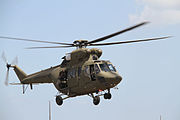
Philippine Air Force W-3A Sokol in combat helicopter paint scheme before transferring to search and rescue role.

Two FA-50 Jets of the Philippine Air Force.

Two Del Pilar-class OPVs at Subic Bay Port

The BRP Artemio Ricarte during the 2008 Balikatan exercise
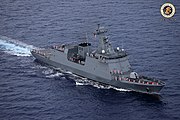
The BRP Jose Rizal, the first purpose-built vessel of the Philippine Navy
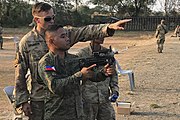
Salaknib Exercise 2019

Balikatan 2019 - Combined-Arms Live Fire at CERAB

Philippine Army M113A2 FSV - 2018 Kalayaan Parade

A LAV-300 vehicle of the Philippine Marine Corps (PMC)
- AFP Flags
 Flag of the Armed Forces of the Philippines
Flag of the Armed Forces of the Philippines Flag of the Philippine Army
Flag of the Philippine Army Flag of the Philippine Air Force
Flag of the Philippine Air Force Flag of the Philippine Navy
Flag of the Philippine Navy Flag of the Philippine Marine Corps
Flag of the Philippine Marine Corps
- AFP Service Patches
 Battledress identification patch of the Armed Forces of the Philippines
Battledress identification patch of the Armed Forces of the Philippines Philippine Army battledress patch
Philippine Army battledress patch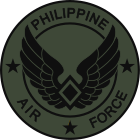 Philippine Air Force battledress patch
Philippine Air Force battledress patch
Philippine Marine Corps battledress pocket patch
 Philippine Navy battledress patch
Philippine Navy battledress patch
(for NAVSOG Personnel in battledress uniform)
- AFP emblems and patches in the Commonwealth Era
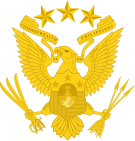 Emblem of the Philippine Commonwealth Armed Forces, 1935-1946
Emblem of the Philippine Commonwealth Armed Forces, 1935-1946 Shoulder patch of the AFP General Staff, 1946-1965
Shoulder patch of the AFP General Staff, 1946-1965
See also[]
- AFP Modernization Act
- Security sector governance and reform in the Philippines
- Awards and decorations of the Armed Forces of the Philippines
- List of AFP Chiefs of Staff
- Women in the Philippine military
- Philippine Constabulary
- Philippine Revolutionary Army
- Military History of the Philippines
- History of the Philippine Army
- List of conflicts in the Philippines
- List of wars involving the Philippines
References[]
- ^ Jump up to: a b c d "2021 Philippines Military Strength". globalfirepower.com.
- ^ "Higher AFP Reserve Force budget needed".
- ^ https://www.janes.com/amp/philippines-outlines-defence-budget-increase-for-2021/ZnlJK3dHVU9mZ28xajRJVkc5dVI5VFp1cVMwPQ2
- ^ Central Intelligence Agency. "The World Factbook: Military Service Age and Obligation". Retrieved February 28, 2016.
17–23 years of age (officers 20–24) for voluntary military service; no conscription; applicants must be single male or female Philippine citizens with either 72 college credit hours (enlisted) or a baccalaureate degree (officers) (2013)
- ^ "Ex-army chief Faustino named AFP chief of staff". Rappler. Retrieved July 30, 2021.
- ^ Gotinga, JC. "Former WESCOM commander now AFP Vice Chief of Staff". Palawan News. Retrieved November 23, 2020.
- ^ "AFP Vice Chief of Staff Collado retires". Manila Bulletin. November 21, 2020.
- ^ "Lt. Gen. Lim bows out of military service, relinquishes post to RAdm Kagaoan". AFP. Retrieved October 3, 2020.
- ^ Ramos, C. "CA confirms AFP's No. 3, military intel chief, 58 other senior officers". Inquirer. Retrieved November 19, 2020.
- ^ "Andres Centino appointed as new Philippine Army chief — Palace". Inquirer. May 16, 2021. Retrieved May 17, 2021.
- ^ Navy Chief Bordado gets third star
- ^ Aguilar, Krissy. "Duterte names Allen Paredes as new Air Force chief". newsinfo.inquirer.net. Retrieved January 16, 2020.
- ^ "New PAF chief willing to be father, friend to Air Force members". www.pna.gov.ph. Retrieved January 17, 2020.
- ^ "DND, AFP welcome new Air Force chief". Manila Bulletin News. Retrieved January 17, 2020.
- ^ Mangosing, F. "Maj. Gen. Ariel Caculitan named new Marines chief". Inquirer. Retrieved December 20, 2020.
- ^ "Army installs new Command Sergeant Major". Philippine Army. Retrieved October 29, 2020.
- ^ Aladin S. Dacayanan is listed as member of the board of trustees of AFPMBAI"AFP Board of trustees". Retrieved February 18, 2021.
- ^ "Speech of President Arroyo during the Commemoration of the Centennial Celebration of the end of the Philippine-American War April 16, 2002". Official Gazette. Government of the Philippines.
- ^ "Commonwealth Act No. 1".
- ^ See for example Manchester, William (1978). American Caesar: Douglas MacArthur 1880–1964. Boston: Little, Brown. ISBN 0-440-30424-5. OCLC 3844481.
- ^ James, D. Clayton (1970). Volume 1, 1880–1941. The Years of MacArthur. Boston: Houghton Mifflin. p. 505. ISBN 0-395-10948-5. OCLC 60070186.
- ^ "Commonwealth Act No. 343 AN ACT TO ABOLISH THE STATE POLICE FORCE, TO REORGANIZE THE PHILIPPINE CONSTABULARY INTO A NATIONAL POLICE FORCE AND PROVIDING FUNDS THEREFOR". June 23, 1938.
- ^ "Executive Ordef No. 153 s. 1938 Reorganizing the Philippine Constabulary into a National Police Force". June 23, 1938.
- ^ Jump up to: a b "Briefer on Ramon Alcaraz". Official Gazette of the Republic of the Philippines. Archived from the original on May 26, 2018. Retrieved May 26, 2018.
- ^ Jump up to: a b c d e Parlade, Antonio G. (2015). An Analysis Of The Communist Insurgency In The Philippines. San Francisco: Pickle Partners Publishing. ISBN 978-1-78625-282-1. OCLC 975223979.CS1 maint: date and year (link)
- ^ Celoza, Albert F. (1997). Ferdinand Marcos and the Philippines: The Political Economy of Authoritarianism. Greenwood Publishing Group. ISBN 9780275941376.
- ^ Magno, Alexander R., ed. (1998). "Democracy at the Crossroads". Kasaysayan, The Story of the Filipino People Volume 9:A Nation Reborn. Hong Kong: Asia Publishing Company Limited.
- ^ Jump up to: a b Lee, Terence (January 2, 2015). Defect Or Defend: Military Responses to Popular Protests in Authoritarian Asia. JHU Press. ISBN 9781421415161.
- ^ Jump up to: a b c Berlin, Donald Lane (1982). Prelude to Martial Law: An Examination of Pre-1972 Philippine Civil-military Relations.
- ^ Jump up to: a b c d e f g h "II: Political Change and Military Transmition in the Philippines, 1966 – 1989: From the Barracks to the Corridors of Power". Official Gazette of the Republic of the Philippines. October 3, 1990. Retrieved July 30, 2021.
- ^ "Declaration of Martial Law". Official Gazette of the Republic of the Philippines. Archived from the original on July 8, 2017. Retrieved September 9, 2018.
- ^ News, ABS-CBN (February 22, 2016). "30 years ago today: Enrile, Ramos withdraw support for Marcos". Retrieved August 2, 2021.
- ^ Jump up to: a b "The military's obsession with UP: some historical notes". Vera Files. Retrieved August 2, 2021.
- ^ De Castro, Renato Cruz, Ph.D. The Dilemma Between Democratic. Control versus Military Reforms: The Case of the AFP Modernisation. Program, 1991-2004. https://ciaotest.cc.columbia.edu/olj/jssm/jssm_3_1/jssm_3_1_car01.pdf
- ^ "Santa Barbara Project – The Classified Missile Project of the Philippines". kbl.org.ph.
- ^ Jump up to: a b c Davide, Hilario G., Jr.; Romulo, Ricardo J.; Legaspi, Leonardo Z.; Hernandez, Carolina G.; Lazaro, Delfin L. "The Final Report of the Fact-Finding Commission: II: Political Change and Military Transmition in the Philippines, 1966 – 1989: From the Barracks to the Corridors of Power". Official Gazette of the Republic of the Philippines – via Republic of the Philippines National Government Portal (Gov.ph).
- ^ Jump up to: a b c GAVILAN, JODESZ (September 21, 2020). "Marcos and his men: Who were the key Martial Law figures?". Rappler. Retrieved August 5, 2021.
- ^ "A FILIPINO ON THE SPOT". The New York Times. October 25, 1984. ISSN 0362-4331. Retrieved August 5, 2021.
- ^ "PHL marks 29th anniversary of Aquino's assassination on Tuesday". Office of the President of the Philippines. August 20, 2012. Archived from the original on February 8, 2016.
- ^ Jump up to: a b c Richard, Lim (March 2011). "Civil-Military Relations in Marcos' Philippines" (PDF). CESRAN Papers. Centre for Strategic Research and Analysis (CESRAN). 2.
- ^ Jump up to: a b c d e "Backgrounder – Security sector reform, professionalization and the shift to external defense in the Philippines". Centre for Security Governance. Retrieved August 2, 2021.
- ^ Jump up to: a b c d e f g h Cruz, Rodel A. (2013). "Security Sector Reform: Way Forward for Democracy and Development" (PDF). National Security Review. National Defense College of the Philippines. December.
- ^ https://www.ateneo.edu/ls/news/research/security-reform-agenda-afp-and-pnp-2018-blueboard-jennifer-santiago-oreta
- ^ "Alfred McCoy, Dark Legacy: Human rights under the Marcos regime". Ateneo de Manila University. September 20, 1999.
- ^ N., Abinales, P. (2005). State and society in the Philippines. Lanham, MD: Rowman & Littlefield Publishers. ISBN 978-0742510234. OCLC 57452454.
- ^ "3,257: Fact checking the Marcos killings, 1975-1985 - The Manila Times Online". www.manilatimes.net. April 12, 2016. Retrieved June 15, 2018.
- ^ "LOOK BACK: The Philippine Constabulary under Marcos". Rappler. Retrieved June 18, 2018.
- ^ W., McCoy, Alfred (2009). Policing America's empire : the United States, the Philippines, and the rise of the surveillance state. Madison, Wis.: University of Wisconsin Press. ISBN 9780299234133. OCLC 550642875.
- ^ "REPORT OF AN AI MISSION TO THE REPUBLIC OF THE PHILIPPINES 1975".
- ^ Robles, Raissa (2016). Marcos Martial Law: Never Again. FILIPINOS FOR A BETTER PHILIPPINES , INC.
- ^ "A FILIPINO ON THE SPOT". Retrieved June 18, 2018.
- ^ Rosenberg, David A. (1974). "Civil Liberties and the Mass Media under Martial Law in the Philippines". Pacific Affairs. 47 (4): 472–484. doi:10.2307/2755948. JSTOR 2755948.
- ^ "MANILA NEWSPAPER CLOSED BY MARCOS". Retrieved June 18, 2018.
- ^ "The One That Got Away | Newsbreak | Independent Journalism". archives.newsbreak-knowledge.ph. Retrieved June 18, 2018.
- ^ "The Haunting of Martial Law: Records from the Marcos Regime". UH School of Law Library. September 7, 2017. Retrieved June 18, 2018.
- ^ Jump up to: a b c "Philippines: State of Conflict and Violence" (PDF). The Asia Foundation Website.
- ^ Jump up to: a b Yegar, Moshe (2002). Between Integration and Secession: The Muslim Communities of the Southern Philippines, Southern Thailand and Western Burma/Myanmar. Lexington Books. pp. 267–268.
- ^ Fallon, Joseph E. (August 1989). "Igorot and Moro National Reemergence". Fourth World Journal. 2 (1). Archived from the original on August 18, 2007. Retrieved September 5, 2007.
- ^ Marites Dañguilan Vitug; Glenda M. Gloria (March 18, 2013). "Jabidah and Merdeka: The inside story". Rappler. Archived from the original on September 13, 2015. Retrieved September 13, 2015.
- ^ "Elections of 1986". Malacanang Presidential Museum and Library. Retrieved August 4, 2021.
- ^ "Speech of President Aquino at the anniversary of Tagumpay ng Bayan, February 16, 2012 (English translation)". Official Gazette of the Republic of the Philippines. Retrieved May 18, 2021.
- ^ Schock, Kurt (1999). "People Power and Political Opportunities: Social Movement Mobilization and Outcomes in the Philippines and Burma". Social Problems. 46 (3): 355–375. doi:10.2307/3097105. ISSN 0037-7791.
- ^ Cruz, Elfren S. "The road to EDSA". Philstar.com. Retrieved May 18, 2021.
- ^ Jump up to: a b Research, P. D. I. (February 13, 2014). "EDSA Day 1: February 22, 1986". Philippine Daily Inquirer. Retrieved August 4, 2021.
- ^ Lingao, Ed. "A 25-year rebellion". Philippine Center for Investigative Journalism Website. Retrieved August 4, 2021.
- ^ Schock, Kurt (1999). "People Power and Political Opportunities: Social Movement Mobilization and Outcomes in the Philippines and Burma". Social Problems. 46 (3): 355–375. doi:10.2307/3097105. ISSN 0037-7791.
- ^ Cruz, Elfren S. "The road to EDSA". Philstar.com. Retrieved May 18, 2021.
- ^ Carter, April (2013). "People Power Since 1980: Examining Reasons for its Spread, Success and Failure". Sicherheit und Frieden (S+F) / Security and Peace. 31 (3): 145–150. ISSN 0175-274X.
- ^ Claudio, Lisandro E. (2013). Taming people's power : the EDSA revolutions and their contradictions. Quezon City. ISBN 978-971-550-655-7. OCLC 864093220.
- ^ "PURSUANT TO RA NO. 6832: Recommendations of the Final Report of the Fact Finding Commission". Philippine Center for Investigative Journalism. Archived from the original on April 17, 2008.
- ^ "R.A. 6832". lawphil.net. Retrieved July 30, 2021.
- ^ "Recommendations of the Final Report of the Fact-Finding Commission". Philippine Center for Investigative Journalism. 2003. Archived from the original on April 17, 2008. Retrieved May 5, 2008.
- ^ Francisco, Katerina (September 21, 2016). "LOOK BACK: The Philippine Constabulary under Marcos". Rappler. Retrieved August 24, 2021.
- ^ "AFP hopes to recruit 20,000 soldiers in 3 years". ANC News. January 15, 2014. Archived from the original on March 2, 2014. Retrieved February 13, 2014.
- ^ "Full implementation of the MILF Normalization Process underway". Office of Presidential Adviser on the Peace Process Website. Retrieved August 30, 2021.
|first=missing|last=(help) - ^ "Bangsamoro Normalization gains momentum". Office of Presidential Adviser on the Peace Process Website. Retrieved August 30, 2021.
|first=missing|last=(help) - ^ AFP Organization, [AFP website].
- ^ https://newsinfo.inquirer.net/1306237/ph-military-adopting-new-titles-chief-of-staff-now-joint-chiefs-chair/amp
- ^ "MaxDefense received confirmation that AFP has deferred the use of the new designation names, President has not yet approved the use of these". July 26, 2020.
- ^ Republic Act No. 6975 (approved December 13, 1990), Chan Robles Law Library.
- ^ Philippine National Police 19th Anniversary (January 28, 2010), Manila Bulletin (archived from the original Archived June 14, 2012, at the Wayback Machine on June 14, 2012).
- ^ "AFP Organization". Archived from the original on April 19, 2008. Retrieved February 3, 2008.
- ^ Jump up to: a b https://www.ateneo.edu/ls/news/research/security-reform-agenda-afp-and-pnp-2018-blueboard-jennifer-santiago-oreta
- ^ https://www.bworldonline.com/security-sector-governance-and-reform-in-southeast-asia/
- ^ Security Sector Governance: Applying the principles of good governance to the security sector (PDF). SSR Backgrounder Series. Geneva: Geneva Centre for the Democratic Control of Armed Forces (DCAF). 2015. Archived (PDF) from the original on September 15, 2017.
- ^ Security System Reform and Governance. DAC Guidelines and Reference Series. Paris: OECD DAC. 2005. ISBN 978-92-64-00786-4.
- ^ Price, Megan; van Veen, Erwin (August 19, 2014). "SSR: Securing its success, justifying its relevance". Clingendael. Archived from the original on August 26, 2017.
- ^ Jump up to: a b https://www.mei.edu/publications/security-sector-reform-philippines
- ^ About the Philippine National police Archived March 26, 2012, at the Wayback Machine
- ^ "Legacies". coastguard.gov.ph. Retrieved August 30, 2021.
- ^ https://hdn.org.ph/wp-content/uploads/2005_PHDR/2005%20Civil_Society_Assessment.pdf
- ^ "Security Reform in the Philippines for 2018". Asia Dialogue. January 29, 2018. Retrieved August 29, 2021.
- ^ Toledo, Mike; Kropholler, Peter (August 24, 2020). "Protect, perform, transform". Annales Henri Lebesgue. 3. pp. 981–998. doi:10.5802/ahl.51. ISSN 2644-9463. Retrieved August 29, 2021.
- ^ Department of National Defense, Republic of the Philippines. TRANSFORMING THE DEPARTMENT OF NATIONAL DEFENSE TO EFFECTIVELY MEET THE DEFENSE AND SECURITY CHALLENGES OF THE 21st CENTURY (PDF) (Technical report).
- ^ Toledo, Mike; Kropholler, Peter (August 24, 2020). "Protect, perform, transform". Annales Henri Lebesgue. 3. pp. 981–998. doi:10.5802/ahl.51. ISSN 2644-9463. Retrieved August 29, 2021.
- ^ "Republic Act No. 7898 : AFP Modernization Act" (PDF). Government of the Philippines. February 23, 1995.
- ^ Jump up to: a b Oreta, Jennifer Santiago (July 12, 2021). "Security sector reform under PNoy and Duterte administrations". BusinessWorld. Retrieved August 5, 2021.
- ^ "REPUBLIC ACT NO. 10349 : AN ACT AMENDING REPUBLIC ACT NO. 7898, ESTABLISHING THE REVISED AFP MODERNIZATION PROGRAM AND FOR OTHER PURPOSES". Government of the Philippines. December 11, 2012.
- ^ Comer 2010, pp. 6–7
- ^ Comer 2010, p. 7
- ^ Comer 2010, p. 8, Philippine Defense Reform (PDR), globalsecurity.org, DND and AFP: Transforming while Performing, Armed forces of the Philippines. (archived from the original Archived January 28, 2006, at the Wayback Machine on January 28, 2006)
- ^ Comer 2010, pp. 12–14
- ^ Comer 2010, p. 14, citing Philippine Defense Reform Handbook, Revised January 31, 2008.
- ^ Comer 2010, p. 16
- ^ Comer 2010, p. 21, Executive Order No. 240, Philippine Supreme Court E-Library. (archived from the original Archived August 15, 2011, at the Wayback Machine on April 29, 2012)
- ^ Comer 2010, p. 18
- ^ Comer 2010, p. 27
- ^ Comer 2010, p. 34
- ^ Jump up to: a b Comer 2010, p. 35
- ^ Comer 2010, p. 36
- ^ Promise 62: Implement the Defense Reform Program Archived March 17, 2011, at the Wayback Machine, ABS-CBN News.
- ^ Aquino Promises Archived March 17, 2011, at the Wayback Machine, ABS-CBN News.
- ^ "Defense.gov News Article: Hagel Praises 'Unbreakable' U.S.-Philippine Alliance".
- ^ "PHL, US inch closer to deal on increased rotational presence of US troops". GMA News Online.
- ^ Department of Environment and Natural Resources/United Nations Development Programme/Marine Environment and Resources Foundation, Inc. (2004) ArcDev: A Framework for Sustainable Archipelagic Development.
- ^ Serafino, N. (2013). Security Assistance Reform: "Section 1206" Background and Issues for Congress. CRS Report for Congress. Accessed from: https://fas.org/sgp/crs/natsec/RS22855.pdf
- ^ Voice of America (August 26, 2013). U.S. Significantly Boosts Military Funding for SE Asia. Voice of America. Accessed from: http://www.voanews.com/content/hagel-se-asia-corrected/1737438.html
- ^ Acosta, Rene (June 23, 2016). "Gazmin closes Philippine Defense Reform Program | Rene Acosta". Retrieved June 18, 2021.
- ^ Maritime Research Information Center (2013). Overview of the MRIC. Naval Station Francisco. Philippine Navy. Taguig, Philippines. Accessed from: "Archived copy". Archived from the original on December 18, 2011. Retrieved June 12, 2014.CS1 maint: archived copy as title (link).
- ^ Executive Order No. 57 by the President of the Philippines. September 6, 2011. Accessed from: "Archived copy" (PDF). Archived from the original (PDF) on August 25, 2013. Retrieved June 12, 2014.CS1 maint: archived copy as title (link).
- ^ https://pia.gov.ph/news/articles/1027673
- ^ Jump up to: a b https://www.senate.gov.ph/press_release/2018/1004_gatchalian1.asp
- ^ Comer, C. (2010). The Parting of the Sulawesi Sea: U.S. Strategy and Transforming the Terrorist Transit Triangle. United States Army Combined Arms Center. Accessed from: http://usacac.army.mil/cac2/call/docs/11-23/ch_13.asp
- ^ "PA shooting team wins Asian Armies Skills at Arms Meet in Australia". balita.ph – Online Filipino News.
- ^ "Philippine Army shooters among the best in the world – The Manila Times Online".
- ^ "Pinoy peacekeepers in Golan Heights conferred prestigious UN medal". GMA News Online.
- ^ Shoulder Ranks (Officers), The Philippine Army.(archived from the original Archived August 1, 2009, at the Wayback Machine on July 1, 2012)
- ^ Philippine Military Rank Insignia, Globalsecurity.org.
- ^ "Ranks". paf.mil.ph. Philippine Air Force. Archived from the original on October 18, 2020. Retrieved May 27, 2021.
- ^ "Ferdinand E. Marcos". Archived from the original on August 4, 2008. Retrieved September 30, 2013., Malacañang Museum.
- ^ "Fidel V. Ramos". Archived from the original on April 30, 2008. Retrieved April 30, 2008.[failed verification], Malacañang Museum.
- ^ Rank insignia of the Philippine armed forces, scribd.com.
- 53rd PC Anniversary Yearbook, 1954 Edition
- Charles 'Ken' Comer, Philippine Defense Reform; Are we there yet?, Asia / South Pacific / India. Russian Military Security Watch, November 2010, U.S. Army Foreign Military Studies Office.
External links[]
- Armed Forces of the Philippines
- Department of National Defense (Philippines)
- Military of the Philippines































